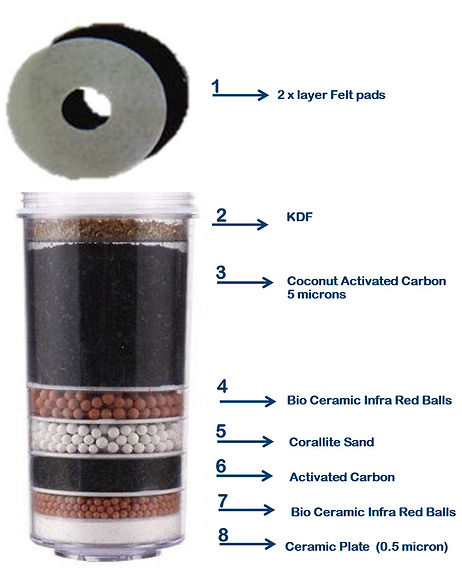4 Filtration mediums works in conjunction to remove organic and chemical impurties from the water; including chlorine, Thrihalomethanes, VOC (Volatile organic Compounds), Heavy metals, as well as bacteria like Ecoli, Giardia & Chriptosporidium.
Bio Far Infra Red balls & Coralite sand adds back much needed trace element to the water: Magnesium, Potasium, Iron, Zinc & Iodene.





There are two principal mechanisms by which activated carbon removes contaminants from water:
Adsorption - activated carbon is perhaps the most powerful absorbent known to man; 500g of carbon contains a surface area of roughly 500m² and can adsorb literally thousands of different chemicals.
Catalytic reduction - a process involving the attraction of negatively-charged contaminant ions to the positively-charged activated carbon.

2 x layer Felt pads in dome—removes rust, sediment and solid particles of 5 Microns and larger
KDF—is a high purity alloy of both copper & zinc especially effective for removing traces of heavy metals like iron, lead, nickel, chromium, cadmium, calcium, aluminium, mercury, arsenic and organic compounds. It is known to kill algae and fungi, control bacteria growth as well as remove chlorine, pesticides and hydrogen sulphide. It also softens the water by changing the form of calcium salts which reduces scale in pipes and appliances. As it also introduces ozone to the water, it creates a hostile and desolate environment for algae, bacteria , and other micro organisms to grow in.
Coconut Activated Carbon - filters up to 5 microns in particle size. 1micron = 1000th of a millimetre in size. It removes Chlorine, Trihalomethanes (a result of chlorination) organic sediment, herbicides and pesticides, reduces heavy metals and improves taste and smell
Bio Ceramic Infra Red Balls - add trace elements of calcium, magnesium, zinc, iodine, iron, potassium and adjust the water to an optimum mild alkaline level and energize the water molecules
Corallite Sand - increases the calcium level and regulates PH levels to increase alkalinity of the water
Activated Carbon - extra level of activated carbon
Bio Ceramic Infra Red Balls—extra level of mineral balls.
Ceramic Plate (0.5 micron)- removes bacteria & microbiolic cysts e.g. E-coli & Giardia

Our Filters
How it works
Granular Activated Carbon Filter (GAC)
There are two principal mechanisms by which activated carbon removes contaminants from water; adsorption and catalytic reduction, a process involving the attraction of negatively-charged contaminant ions to the positively-charged activated carbon. Organic compounds are removed by adsorption and residual disinfectants such as chlorine and chloramines are removed by catalytic reduction.
Carbon is highly porous and 500g of carbon contains a surface area of roughly 0.5 km² and can absorb literally thousands of different chemicals. Activated carbon has a slight electro-positive charge added to it; as the water passes over the positively charged carbon surface, the negative ions of the contaminants are drawn to the surface of the carbon granules.
Activated carbon filters remove/reduce many volatile organic chemicals (VOC), pesticides and herbicides, as well as chlorine, benzene, trihalomethane (THM) compounds, radon, solvents and hundreds of other man-made chemicals found in tap water. Some activated carbon filters are moderately effective at removing some, but not all, heavy metals. Some iron, manganese, and hydrogen sulfide will also be removed by higher quality activated carbon filters. GAC does not remove sediment / particulate material very well, so they are often preceded by a sediment filter (cloth filter). Sediment pre-filters also prolong the activate carbon cartridge life by eliminating gross contaminants that would otherwise clog the activated carbon thereby reducing the surface area available for absorption.
Activated carbon filters are usually rated by the size of the particles they are able to remove, measured in microns, and generally range from 50 microns (least effective) down to 0.5 microns (most effective), which is what is used in our filters. 1 Micron = 1000th of a millimetre in size. (Eg. 20 Microns is a strand of hair – 10 Microns is a grain of sand.)
The most common carbon types used in water filtration are bituminous, wood, and coconut shell carbons. While coconut shell carbon typically costs 20% more than the others, it is generally regarded as the most effective of the three. All of our filters use coconut shell carbon.
Activated carbon filters require very little maintenance, however, it is very important to ensure that filter replacement schedules are followed to ensure proper filtration at all times. Do not wait for bad tastes and odours to return to the water before deciding the filter needs replacement as this is an indication that the filter is no longer able to completely remove contaminants and that it has surpassed its service life.



